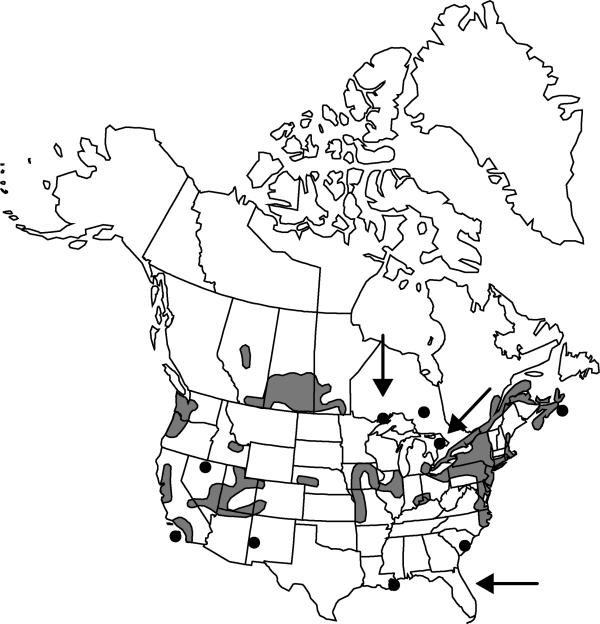Atriplex prostrata
in J. Lamarck and A. P. de Candolle, Fl. Franç. ed. 3, 3: 387. 1805.
Herbs, monoecious, erect, decumbent or procumbent, branching, 1–10 dm; stems subangular to angular, green or striped. Leaves opposite or subopposite at least proximally; petiole (0–) 1–3 (–4) cm; blade triangular-hastate, lobes spreading, 20–100 mm and almost as wide, base truncate or subcordate, margin entire, serrate, dentate, or irregularly toothed, apex acute to obtuse. Flowers in spiciform naked spikes 2–9 cm, sometimes forming terminal panicles; glomerules tight, contiguous or irregularly spaced. Fruiting bracteoles green, becoming brown to black at maturity, triangular-hastate to triangular-ovate, veined or veins obscure, 3–5 mm, thin to thickened, spongy, base truncate to obtuse, margin united at base, lateral angles mostly entire, apex acute, faces smooth or with 2 tubercles. Seeds dimorphic: brown, flattened, disc-shaped, 1–2.5 mm wide, or black, 1–1.5 mm wide; radicle subbasal, obliquely antrorse to spreading. 2n = 18.
Phenology: Flowering in summer–fall.
Habitat: Sea beaches, salt marshes or other saline habitats
Elevation: 0-2000 m
Distribution

Introduced; Alta., Man., N.B., N.S., Ont., P.E.I., Que., Sask., Ariz., Calif., Colo., Conn., Del., Idaho, Ill., Ind., Iowa, Kans., Ky., Maine, Md., Mass., Mich., Minn., Mo., Mont., Nebr., Nev., N.H., N.J., N.Mex., N.Y., N.C., Ohio, Oreg., Pa., R.I., Utah, Va., Wash., Eurasia
Discussion
Atriplex prostrata often grows with willow, tamarix, Scirpus (Schoenoplectus and Bulboschoenus segregates), Juncus, Distichlis, and Typha. Perhaps the phase along coastal eastern North America is indigenous, but this and the related Atriplex heterosperma evidently moved quickly from one palustrine habitat to another following subsequent introductions from the Old World. They were probably initially introduced as ballast waifs, and subsequently dispersed by waterfowl. The two species are now commonplace in lands within and adjacent to marshes in much of North America west of the initial sites of introduction.
The name for the species taken up here follows the nomenclatural interpretation of J. McNeill et al. (1983).
Selected References
None.
Lower Taxa
"thin" is not a number. "thickened" is not a number.
